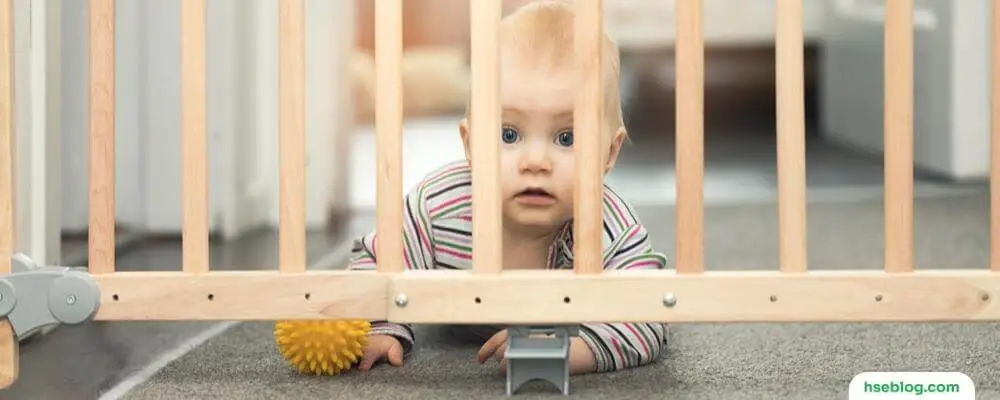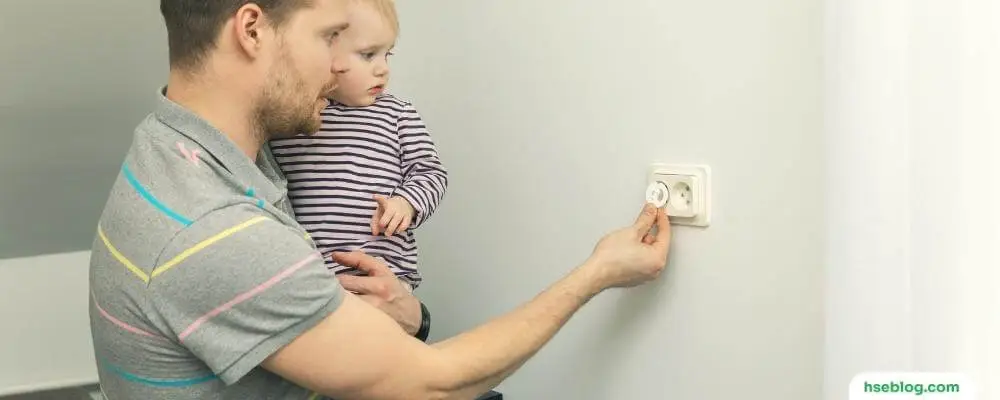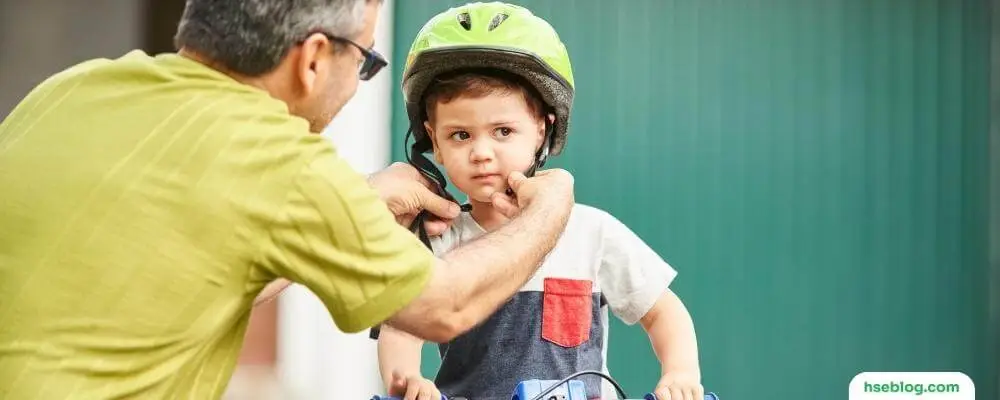The safety of our children is a top priority for every parent. Our homes represent a place of security and comfort in our daily lives. Yet, they can also pose many risks to our little ones without the proper precautions. From the living room to the kitchen, each area has potential hazards that must be addressed.
In this blog post, we’ll delve into 10 essential safety rules that can help transform your home into a safe haven for your child. Whether it’s avoiding stranger danger, understanding fire safety, or knowing the importance of water safety, these rules aim to educate parents and children, minimizing risks and creating a secure environment where kids can safely learn and grow. So, let’s start our journey toward a safer home.
10 Safety Rules At Home For Child | Kids Safety
Safety rules for kids at home can be tricky for some parents. Many parents may want to keep their kids safe but may not know how to do so. That’s why we’ve devised a list of 10 safety rules to keep kids safe at home.

1. Never leave your child unattended
Keeping a vigilant eye on your child is crucial for their safety. This means not only when they are actively playing but also when eating or sleeping. Young children, especially those under five, have a heightened risk of choking on food or small objects, so they must be supervised during meals. When sleeping, especially for infants, there’s a risk of Sudden Infant Death Syndrome (SIDS) that can be mitigated by regular checks.
Furthermore, children’s inherent curiosity and lack of danger perception can lead them to hazardous playtime situations. Hence constant monitoring is key. If you need to leave the room or get distracted, you should ideally take your child with you or ensure they’re under the supervision of another responsible adult to minimize any risks.
2. Create a safe space for your child
Creating a safe space for your child within your home is vital in ensuring their safety. This entails designating a specific area for them to play where potential hazards have been minimized through childproofing. Childproofing might involve securing furniture to prevent it from toppling over, using corner protectors to reduce the risk of sharp edge injuries, covering electrical outlets, and keeping small objects that can be a choking hazard out of reach.
Providing safe toys is another important aspect of this process. Stuffed animals, blocks, and non-toxic markers are great examples, as they stimulate creativity and cognitive development and are less likely to cause harm. It’s important to regularly check these toys for wear and tear to prevent any accidents. Thus, a safe play space combined with appropriate toys can provide a secure environment for your child to explore and learn.

3. Teach your child about stranger danger
Educating your child about “stranger danger” is crucial to ensuring their safety. This involves teaching them to recognize potentially harmful situations and avoid interactions with individuals they do not know, especially in the absence of trusted adults. Children should know it’s unsafe to converse with strangers, let alone accompany them without permission. If they find themselves approached by a stranger, you should teach them to act immediately, such as shouting for help and running to a safe, populated location.
The concept of stranger danger should not merely be taught as a rule, but the rationale behind the rule must also be communicated. This includes explaining the potential dangers a stranger could pose and the importance of always alerting trusted adults about any suspicious interactions. This education enables them to better understand the risks and equips them to respond effectively in such scenarios.
4. Not to open the door to strangers
Implementing a strict rule against opening the door to strangers is a significant safety measure. Children should be taught to ask who’s at the door before even considering opening it. They must be reinforced with the understanding that they should never open the door for someone unfamiliar, regardless of any reasons or incentives the stranger may provide. These lessons can start at a very early age.
By regularly reviewing these safety rules and holding detailed discussions, parents can emphasize the potential dangers and help children understand why these rules exist. It’s also important to assure children that ignoring the door is okay if they’re unsure or alone. Such precautions can significantly minimize risks and help maintain your child’s safety within the confines of your home.

5. Keep dangerous objects out of reach
Safeguarding your home from potential hazards involves keeping dangerous objects out of children’s reach. This includes objects that can cause physical harm, such as knives, scissors, or tools, and substances that could be hazardous if ingested or handled improperly, such as cleaning products, medications, and certain houseplants. All these items should be stored securely in a high, locked, or childproofed cabinet that a child cannot access.
It’s equally important to keep these objects secured even after use and not leave them unattended on tables or countertops where children can reach them. By enforcing this rule consistently, you can prevent many accidents, from cuts and scrapes to more severe injuries or poisoning. It’s all about creating a safer environment where your child can freely explore without being exposed to unnecessary risks.
6. Educate your child about fire safety
Fire safety education is an essential part of childproofing your home. Teaching children what to do in a fire can be lifesaving. Explain the importance of not hiding but getting out of the house as quickly and safely as possible. While demonstrating how to use a fire extinguisher can be beneficial, the main focus should be escaping the premises and calling 911 since handling a fire extinguisher might be too complex for younger children. If applicable, show them the quickest routes to the exits and where the fire escapes are.
For older children who can understand more complex procedures, teach them how to safely turn off electricity and gas supplies if it’s safe to do so. But remember, the key to effective fire safety is practicing these steps regularly. Regular drills can help reinforce the lessons, making them second nature and ensuring your child can react calmly and efficiently during an emergency.

7. Install safety devices in your home
Installing safety devices in your home is an effective way to enhance childproofing measures and prevent potential accidents. Smoke detectors are necessary, with at least one recommended for each level of your home. These should be checked monthly to ensure they function correctly and batteries are replaced as necessary. Similarly, carbon monoxide detectors are crucial, as this gas is odorless and colorless, making it undetectable without proper equipment, yet it can be lethal in high concentrations.
Additionally, secure locks on doors and windows can prevent children from wandering outside unsupervised, and if you have a pool, a locked gate can prevent accidental falls and potential drownings. Safety devices like these act as additional layers of protection that help to maintain a secure environment for your child.
8. Educate Them About Water Safety
Water safety is essential to childproofing, particularly for households with access to pools, ponds, or other bodies of water. The rules should start with never leaving a bathtub or sink filled with water unattended, as even small amounts of water can pose a drowning risk to young children. Similarly, children should be taught to never go near a pool, pond, or any other body of water without an adult. In the case of home swimming pools, consider installing barriers or safety fences to prevent unsupervised access.
Additionally, as children grow, swimming lessons can be a valuable investment for fun, exercise, and a key survival skill. It’s important to remember that while water can be a source of fun, it can also be dangerous, and these safety measures are necessary to prevent tragic accidents.

9. Practice safety drills
Practicing safety drills at home is a valuable approach to reinforce the various safety rules you’ve taught your children. Children, especially young ones, may struggle to distinguish between safe and dangerous situations or objects. By engaging in practical exercises like fire evacuation drills, they can learn through experience and understand the seriousness of these situations.
Like the illustrated signs in schools and daycares that indicate potential hazards, parents can utilize visual aids or indicators at home to help children identify potential dangers. It could be marking cleaning supply cabinets, demonstrating how to safely navigate stairs, or showing the safe routes to exit the house. These practices, combined with regular discussions about safety and rules, will greatly enhance your child’s understanding of safety at home and their ability to respond effectively in emergencies.
10. Stay informed about safety risks
Staying informed about potential safety risks in your vicinity is crucial to ensuring your child’s safety. This means keeping up-to-date with local news reports, which could alert you to potential dangers in your area, such as criminal activity, natural disasters, or even recalls on children’s products. Trusted safety-related websites can provide knowledge about childproofing your home, recognizing hazards, and responding to emergencies. Printed information, such as pamphlets and guides, can serve as quick reference materials and are often available from health centers, schools, and community centers.
Additionally, maintaining open communication with your child’s caregivers ensures you’re aware of any issues or potential risks that might arise while you’re not with your child. Regular check-ins can help you address concerns promptly, update safety measures as needed, and ensure the consistency of your child’s safety rules.
Conclusion
In conclusion, maintaining a safe environment at home for our children is a responsibility that requires constant vigilance and education. By implementing the ten safety rules highlighted above — from continuous supervision, creating safe spaces, and teaching about stranger danger, to installing safety devices and staying informed about local safety risks —we can significantly minimize hazards and protect our children from harm.
Remember, every child’s safety needs may be unique, so adjusting these guidelines according to your home and your child’s age and development is crucial. Ultimately, these safety measures create a secure space where children can explore, learn, and grow confidently, providing parents and caregivers peace of mind.

